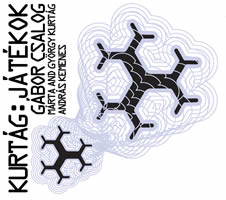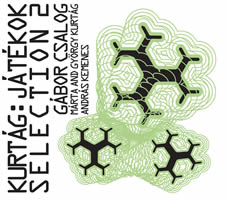Kurtág in New York, Me in Michigan
|
Dan Albertson [March 2009.] [With gratitude to Szabó Bálint for his generous help et plusieurs remerciements à G.K. — D.A.]
György KURTÁG: Játékok (exc.). Gábor Csalog (pno), with guests András Kemenes (pno), Márta & György Kurtág (both upright pno with supersordino pedal) and Alíz Asztalos and Ha Neul-Bit (pno, speaking). BMC Records CD 123 (http://www.bmcrecords.hu/). György KURTÁG: …concertante… (2002-03, rev. 2006); Zwiegespräch (with György KURTÁG, Jr.) (1999-2006); Hipartita (2000-04); Játékok and transcriptions (exc.). Hiromi Kikuchi (vln), Ken Hakii (vla), Márta & György Kurtág (amplified upright pno with supersordino pedal), György Kurtág, Jr. (synth), Keller Quartet, Hungarian National Philharmonic Orchestra, Zoltán Kocsis (cond.). BMC Records CD 129 (http://www.bmcrecords.hu/). György KURTÁG: Játékok (exc.). Gábor Csalog (pno), with guests András Kemenes (pno), György Kurtág (pno & upright pno), Márta Kurtág (pno) and Alíz Asztalos (pno, speaking). BMC Records CD 139 (http://www.bmcrecords.hu/). Distributed in the US by Forte Distribution (http://www.shopforte.com/). The Kurtágs made their long-awaited New York début early last month as part of a two-night Hungarian focus at Carnegie Hall, a bold move made possible by the Hungarian Cultural Center. My own celebrations were limited to my small corner of Michigan, where I spent time with three recent releases from the composer’s native land. These issues include a generous representation of his ongoing diary Játékok (Games) alongside recent chamber, orchestral and solo forays. The first disc to appear includes some première recordings amongst the colorful parade of pieces from the first eight books of Játékok. A natural comparison to Bartók’s six books of Mikrokosmos is facile and in the wrong spirit here; Kurtág is much less concerned with musical pedagogy than with documenting his world, though a didactic purpose is not to be excluded from some of these countless miniatures. On this recording, Gábor Csalog cross-pollinates music from various decades and various books; he is joined by András Kemenes in four excerpts, while Kemenes alone plays two, Márta alone plays two, György alone one, and the Kurtágs together play two more. Two curious interludes charm: One is played and sung by Ha Neul-Bit, giving a Magyar lesson, and the other by Alíz Asztalos playing and vocalizing. The results are not always convincing as a through-composed suite, but the wonder of Játékok is that if one is dismayed by a particular piece, the remedy is a wait of 30 or so seconds and a new piece to behold. CDs enable listener programming, and I am confident others will find their own justifications and methodologies. I especially enjoyed hearing miniatures in which a single aspect of piano technique is explored, and those that make allusions to Kurtág’s own music. The middle item is, because of its varied contents, the most rewarding and is in fact a double-CD set. An orchestral piece by Kurtág is always to be anticipated and his latest, …concertante… for violin, viola and orchestra, is much less accessible than its predecessor, Stele (1994). A common link with that piece is the use of a large orchestra in an utterly microscopic manner, with perhaps no tutti sections and very few in which more than one or two subgroups play at once. I could imagine a description of the piece as a series of monologues and dialogues, both among the two soloists and the roster of ripieno instruments, yet the primary impression left by the piece is increasing solitude rather than growing unity. I was transfixed despite the lack of easy entry points. A version of the in-progress work Zwiegespräch for synthesizer and string quartet sees senior and junior Kurtágs resuming a collaboration first heard almost 20 years ago in Mémoire de Laïka. The order of the movements, per the accompanying text, is arbitrary, but the sequence chosen for the disc makes linear sense and I appreciate the gentle use of synthesizer to darken the palette familiar from the 1970s gem Microludes. Disc two begins with Hipartita, which takes a new look at the arrangement specified in Nono’s late Lontananza and is only one result of Kurtág’s recent muse, Hiromi Kikuchi. Here Kurtág uses 11 music stands in a semi-circle, visited by the violinist during the course of the work’s eight movements. Though the first six movements have memorable peaks, I sensed a lack of direction. The heft of the piece is reserved for the end. The seventh movement (…perpetuum mobile…) and the eighth (Heimweh – Hommage à Péter Eötvös) are undeniably characteristic of the Kurtág aesthetic, at once mercurial and saturnine. The preceding three works were recorded at Budapest’s Kurtág 80 Festival in 2006, though only Hipartita contains applause, for reasons of flow explained in the booklet. The disc’s conclusion, also with its applause retained, dates from the Kurtágs’ farewell Vienna concert (autumn 2006) and includes a sequence of Játékok, two faithful and loving Bach transcriptions and a canon from Bartók’s first book of Mikrokosmos. The aura of the occasion translates very well to the home environment, so sincere is the performance and so tender the audience response. The sound of the composer’s preferred upright piano is also an asset, responding to the sundry demands entailed in these scores. The last disc returns to Játékok and includes, for the first time, excerpts from the eighth and ninth books and the contemplative Bach sinfonia to Gottes Zeit ist die allerbeste Zeit, also on the live disc. A total of 52 pieces is recorded, but six of these are repeats; four feature György Kurtág on upright piano, one of which is a repeat. The other totals are Márta on one excerpt, Márta and György on one, Kemenes on one and Asztalos on one, once more as both pianist and vocalist. Again the music is a tapestry of impressions and styles, memories and recreations, occasions and fantasies, with static series alternating with bustle in a manner quite similar at times to his larger-scale works. Almost as fascinating as the music are Miklós Dolinszky’s essay and the black-and-white family photographs by István Huszti. Taken as a whole, these three discs give us almost 120 unique Játékok shards, a mere glimpse at the totality. Those easily tired by piano discs (like me) should find enough surprises here to stave off ennui; those seeking an introduction to Kurtág’s newer output may be served best by BMC CD 129, which reveals the protean composer both consolidating and expanding his language.
[More Dan Albertson]
[More
Kurtág]
[Previous Article:
La Rondine, Orfeo ed Euridice, Thaïs, etc.]
[Next Article:
Beethoven’s Diabelli Variations, Op. 120, Part 3.]
|


